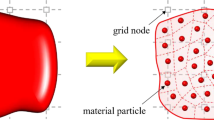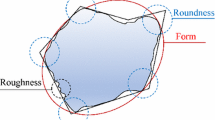Abstract
In this study, moving least square (MLS) shape functions are employed to reduce the cell-crossing error occurred in conventional material point method (MPM) when material particles pass through grid cell boundaries. The level of smoothness of MLS shape functions for mapping information from material particles to a background grid can be controlled by the support size of MLS weight functions. A simple method is proposed to reduce the computational cost for evaluating MLS shape functions at material particles by interpolating pre-computed MLS shape function values at sampling points in a grid cell. Numerical results show that the present method is very effective to reduce the cell-crossing error in MPM computations.





















Similar content being viewed by others
References
André D, Girardot J, Hubert C (2019) A novel DEM approach for modeling brittle elastic media based on distinct lattice spring model. Comput Methods Appl Mech Eng 350:100–122. https://doi.org/10.1016/j.cma.2019.03.013
Frissane H, Taddei L, Lebaal N, Roth S (2019) 3D smooth particle hydrodynamics modeling for high velocity penetrating impact using GPU: application to a blunt projectile penetrating thin steel plates. Comput Methods Appl Mech Eng 357:112590. https://doi.org/10.1016/j.cma.2019.112590
Ni T, Zaccariotto M, Zhu QZ, Galvanetto U (2019) Static solution of crack propagation problems in Peridynamics. Comput Methods Appl Mech Eng 346:126–151. https://doi.org/10.1016/j.cma.2018.11.028
Sulsky D, Chen Z, Schreyer HL (1994) A particle method for history-dependent materials. Comput Methods Appl Mech Eng 118:179–196. https://doi.org/10.1016/0045-7825(94)90112-0
Sulsky D, Zhou SJ, Schreyer HL (1995) Application of a particle-in-cell method to solid mechanics. Comput Phys Commun 87:236–252. https://doi.org/10.1016/0010-4655(94)00170-7
Guo YJ, Nairn JA (2006) Three-dimensional dynamic fracture analysis using the material point method. Comput Model Eng Sci 16:141–155. https://doi.org/10.3970/cmes.2006.016.141
Cheon YJ, Kim HG (2018) An efficient contact algorithm for the interaction of material particles with finite elements. Comput Methods Appl Mech Eng 335:631–659. https://doi.org/10.1016/j.cma.2018.02.005
York AR, Sulsky D, Schreyer HL (2000) Fluid-membrane interaction based on the material point method. Int J Numer Methods Eng 48:901–924. https://doi.org/10.1002/(SICI)1097-0207(20000630)48:6%3c901:AID-NME910%3e3.0.CO;2-T
Soga K, Alonso E, Yerro A et al (2016) Trends in large-deformation analysis of landslide mass movements with particular emphasis on the material point method. Géotechnique 66:248–273. https://doi.org/10.1680/jgeot.15.LM.005
Yamaguchi Y, Takase S, Moriguchi S, Terada K (2020) Solid–liquid coupled material point method for simulation of ground collapse with fluidization. Comput Part Mech 7:209–223. https://doi.org/10.1007/s40571-019-00249-w
Raymond SJ, Jones B, Williams JR (2018) A strategy to couple the material point method (MPM) and smoothed particle hydrodynamics (SPH) computational techniques. Comput Part Mech 5:49–58. https://doi.org/10.1007/s40571-016-0149-9
Nairn JA (2019) Modeling heat flow across material interfaces and cracks using the material point method. Comput Part Mech 6:133–144. https://doi.org/10.1007/s40571-018-0201-z
Steffen M, Kirby RM, Berzins M (2008) Analysis and reduction of quadrature errors in the material point method (MPM). Int J Numer Methods Eng 76:922–948. https://doi.org/10.1002/nme.2360
Zhang X, Chen Z, Liu Y (2017) The material point method. Elsevier, Amsterdam
Bardenhagen SG, Kober EM (2004) The generalized interpolation material point method. Comput Model Eng Sci 5:477–495. https://doi.org/10.3970/cmes.2004.005.477
Sadeghirad A, Brannon RM, Burghardt J (2011) A convected particle domain interpolation technique to extend applicability of the material point method for problems involving massive deformations. Int J Numer Methods Eng 86:1435–1456. https://doi.org/10.1002/nme.3110
Sadeghirad A, Brannon RM, Guilkey JE (2013) Second-order convected particle domain interpolation (CPDI2) with enrichment for weak discontinuities at material interfaces. Int J Numer Methods Eng 95:928–952. https://doi.org/10.1002/nme.4526
Wang L, Coombs WM, Augarde CE et al (2019) On the use of domain-based material point methods for problems involving large distortion. Comput Methods Appl Mech Eng 355:1003–1025. https://doi.org/10.1016/j.cma.2019.07.011
Zhang DZ, Ma X, Giguere PT (2011) Material point method enhanced by modified gradient of shape function. J Comput Phys 230:6379–6398. https://doi.org/10.1016/j.jcp.2011.04.032
Pruijn NS (2016) The improvement of the material point method by increasing efficiency and accuracy. Delft University of Technology
Tielen R, Wobbes E, Möller M, Beuth L (2017) A high order material point method. Procedia Eng 175:265–272. https://doi.org/10.1016/j.proeng.2017.01.022
Gan Y, Sun Z, Chen Z et al (2018) Enhancement of the material point method using B-spline basis functions. Int J Numer Methods Eng 113:411–431. https://doi.org/10.1002/nme.5620
de Koster P, Tielen R, Wobbes E, Möller M (2020) Extension of B-spline Material Point Method for unstructured triangular grids using Powell-Sabin splines. Comput Part Mech. https://doi.org/10.1007/s40571-020-00328-3
Wobbes E, Möller M, Galavi V, Vuik C (2019) Conservative Taylor least squares reconstruction with application to material point methods. Int J Numer Methods Eng 117:271–290. https://doi.org/10.1002/nme.5956
Liang Y, Zhang X, Liu Y (2019) An efficient staggered grid material point method. Comput Methods Appl Mech Eng 352:85–109. https://doi.org/10.1016/j.cma.2019.04.024
Lancaster P, Salkauskas K (1981) Surfaces generated by moving least squares methods. Math Comput 37:141. https://doi.org/10.2307/2007507
Belytschko T, Lu YY, Gu L (1994) Element-free Galerkin methods. Int J Numer Methods Eng 37:229–256. https://doi.org/10.1002/nme.1620370205
Liu WK, Jun S, Zhang YF (1995) Reproducing kernel particle methods. Int J Numer Methods Fluids 20:1081–1106. https://doi.org/10.1002/fld.1650200824
Kim HG (2002) Interface element method (IEM) for a partitioned system with non-matching interfaces. Comput Methods Appl Mech Eng 191:3165–3194. https://doi.org/10.1016/S0045-7825(02)00255-4
Dilts GA (1999) Moving least-squares particle hydrodynamics I. Consistency and stability. Int J Numer Methods Eng 44:1115–1155. https://doi.org/10.1002/(SICI)1097-0207(19990320)44:8%3c1115:AID-NME547%3e3.0.CO;2-L
Dilts GA (2000) Moving least-squares particle hydrodynamics II: conservation and boundaries. Int J Numer Methods Eng 48:1503–1524. https://doi.org/10.1002/1097-0207(20000810)48:10%3c1503:AID-NME832%3e3.0.CO;2-D
Brownlee R, Houston P, Levesley J, Rosswog S (2006) Enhancing SPH using moving least-squares and radial basis functions. In: Iske A, Levesley J (eds) Algorithms for approximation. Springer, Berlin, pp 103–112
Salehi R, Dehghan M (2013) A moving least square reproducing polynomial meshless method. Appl Numer Math 69:34–58. https://doi.org/10.1016/j.apnum.2013.03.001
Sulsky D, Gong M (2016) Improving the material-point method. In: Weinberg K, Pandolfi A (eds) Lecture notes in applied and computational mechanics. Springer, Berlin, pp 217–240
Hu Y, Fang Y, Ge Z et al (2018) A moving least squares material point method with displacement discontinuity and two-way rigid body coupling. ACM Trans Graph 37:1–14. https://doi.org/10.1145/3197517.3201293
Song Y, Liu Y, Zhang X (2020) A transport point method for complex flow problems with free surface. Comput Part Mech 7:377–391. https://doi.org/10.1007/s40571-019-00282-9
Belytschko T, Krongauz Y, Organ D et al (1996) Meshless methods: an overview and recent developments. Comput Methods Appl Mech Eng 139:3–47. https://doi.org/10.1016/S0045-7825(96)01078-X
Atluri SN, Kim H-G, Cho JY (1999) A critical assessment of the truly meshless local Petrov-Galerkin (MLPG), and local boundary integral equation (LBIE) methods. Comput Mech 24:348–372. https://doi.org/10.1007/s004660050457
Daphalapurkar NP, Lu H, Coker D, Komanduri R (2007) Simulation of dynamic crack growth using the generalized interpolation material point (GIMP) method. Int J Fract 143:79–102. https://doi.org/10.1007/s10704-007-9051-z
Acknowledgements
This work was supported by the National Research Foundation of Korea (NRF) grant funded by the Korea government (MSIT) (No. 2018R1A2B6006234).
Author information
Authors and Affiliations
Corresponding author
Ethics declarations
Conflict of interest
On behalf of all authors, the corresponding author states that there is no conflict of interest.
Additional information
Publisher's Note
Springer Nature remains neutral with regard to jurisdictional claims in published maps and institutional affiliations.
Rights and permissions
About this article
Cite this article
Song, JU., Kim, HG. An improved material point method using moving least square shape functions. Comp. Part. Mech. 8, 751–766 (2021). https://doi.org/10.1007/s40571-020-00368-9
Received:
Revised:
Accepted:
Published:
Issue Date:
DOI: https://doi.org/10.1007/s40571-020-00368-9




